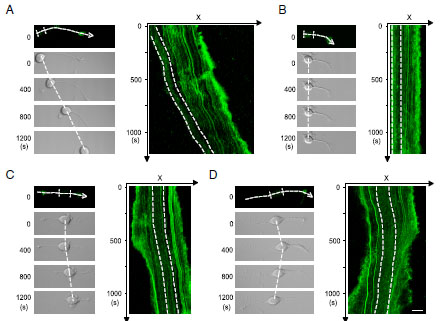Time:2010-08-19
On Aug. 11, the Journal of Neuroscience published a research article from ION entitled "Leading Tip Drives Soma Translocation via Forward F-Actin Flow during Neuronal Migration". This work was mainly carried out by graduate student Min He and postdoctoral fellow Zheng-hong Zhang, under the supervision of Dr. Xiao-bing Yuan.
Neuronal migration involves coordinated extension of the leading process and translocation of the soma, but the relative contribution of different subcellular regions, including the leading process and cell rear, in driving soma translocation remains unclear. By local manipulation of cytoskeletal components in restricted regions of cultured neurons, Min He and colleagues examined the molecular machinery underlying the generation of traction force for soma translocation during neuronal migration. They found that actively migrating neurons exhibit high dynamics in the growth cone (GC)-like structure at the leading tip and severing the tip or disrupting its dynamics suppressed soma translocation within minutes. Soma translocation was also suppressed by local disruption of F-actin along the leading process but not at the soma, whereas disrupting microtubules along the leading process or at the soma accelerated soma translocation. Fluorescent speckle microscopy using GFP-alpha-actinin showed that a forward F-actin flow along the leading process correlated with and was required for soma translocation, and such F-actin flow depended on a front-high and back-low difference in myosin II activity. These results suggest that the tip of the leading process actively pulls the soma forward during neuronal migration through a myosin II-dependent forward F-actin flow along the leading process.

F-actin flow in migrating and non-migrating neurons as revealed by FSM.
This work was supported by grants from MOST, NSF, and CAS.
 附件下载:
附件下载: